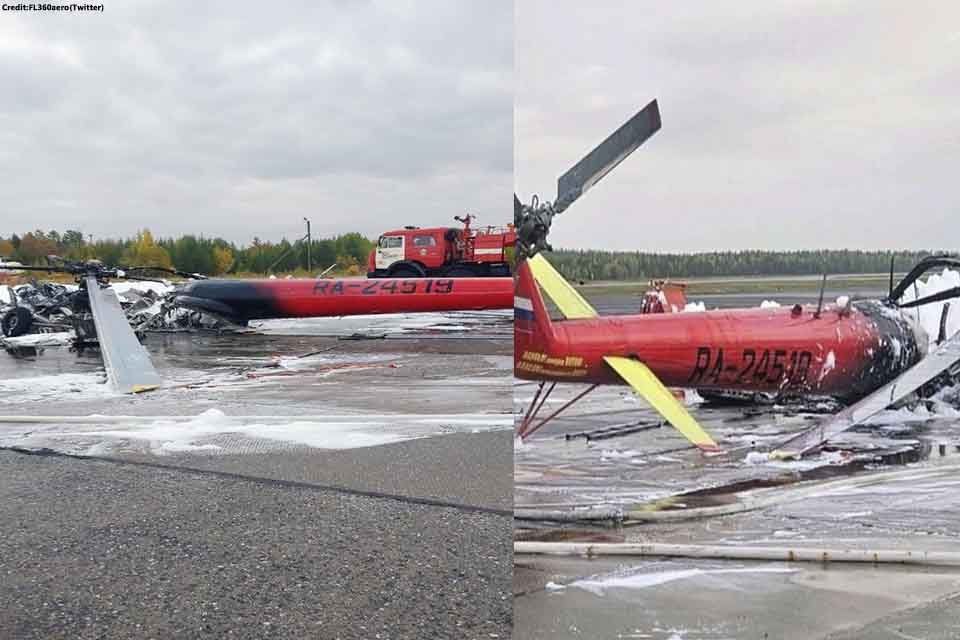Aviation
Two Russian Schoolboys Arrested for Destroying Mi-8T Helicopter

In a shocking act of sabotage, two Russian teenagers, aged 13 and 14, have been arrested for burning down a Mi-8T military helicopter at an airport.
The boys, Timur and Sasha, reportedly used flammable liquid and cigarettes to ignite the helicopter, resulting in a fiery explosion that caused severe damage, leaving the aircraft almost completely destroyed.
A Costly Mistake: Passenger Pays for Fuel After Disruptive Flight
According to reports by Russian media outlet BAZA, which has close ties to law enforcement, the teenagers claimed they were promised around £42,000 through the Telegram messaging app in exchange for carrying out the attack.
While the source of the offer remains unknown, one theory suggests the boys may have been motivated by the hope that the act could somehow help bring home the father of one of the teenagers, who had been conscripted to fight in the war in Ukraine.
Egypt has signed an agreement with China to purchase J-10C fighter jets
The destruction of the £1 million helicopter led to their immediate arrest, as the boys suffered significant facial and hand burns during the incident. After fleeing the scene, they sought medical assistance, which ultimately revealed their involvement in the attack. Both teenagers are now under armed guard while receiving treatment in a local hospital.
Authorities revealed that this was not the first act of sabotage carried out by the boys. Earlier, they confessed to being paid £250 to destroy a mobile phone mast, which they successfully completed before targeting the helicopter. During their interrogation, they admitted to receiving 30,000 rubles for setting fire to the cell tower and were promised 5 million rubles for the helicopter attack.
The Mi-8T helicopter, used for military purposes, was reportedly left “almost completely wrecked,” with only the tail remaining intact following the explosion.

Aviation
Airbus Enhances A350 Cabin with 10-Abreast Seating

Airbus has announced a new partnership with Jiatai Aircraft Equipment, a Chinese aircraft seating manufacturer, to supply upgraded economy-class seats for the A350 widebody series.
This collaboration, unveiled at the 2024 Airshow China, focuses on developing a newly designed economy seat tailored for the A350‘s New Production Standard (NPS) cabin.
One of the key features of the NPS cabin is the ability to accommodate 17-inch wide economy seats, compared to the previous 16.5-inch wide seats that airlines were limited to in the A350’s earlier configurations.
British Airways Unveils Its Brand-New First Class Cabin for the Airbus A380
This change is made possible by the expanded space in the NPS cabin, which is 35 inches longer and 4 inches wider than the previous version. This extra space is achieved by slightly moving the cockpit wall forward and shifting the rear pressure bulkhead back by one frame.
The wider cabin allows airlines to add up to 30 extra economy seats without compromising comfort. For airlines opting for a 3-4-3 seating layout, the 17-inch wide seats are an excellent choice for a more comfortable passenger experience. However, some airlines, such as Iberia, may choose to retain a 9-abreast layout with wider seats for added comfort.
The NPS cabin also offers enhanced flexibility for airline operators. One major advantage is the ability to easily switch between a 9-abreast and 10-abreast seating configuration without requiring significant downtime for aircraft reconfiguration. Airlines can use the same seat rails, tracks, and IFE interfaces, making the transition smoother and quicker.
Etihad Airways Unveils 10 Exciting New Routes for 2025
In addition, the design of the floor attachments and air-conditioning systems has been optimized for 10-abreast seating, meaning airlines can upgrade their cabins without needing to make substantial modifications to the aircraft’s structure.
Though it’s still unclear when Jiatai’s economy-class seats will be officially added to the A350’s Buyer Furnished Equipment (BFE) catalogue, the collaboration marks a significant step toward enhancing the A350’s cabin offerings.
With this partnership, Airbus is providing more seating options for airlines, ensuring that they can meet diverse customer needs while improving overall operational efficiency.
-

 Aviation2 months ago
Aviation2 months agoMicrosoft Flight Simulator Raises $3 Million to Bring Back the An-225 Mriya
-

 Airlines2 months ago
Airlines2 months agoQatar Citizens Can Travel to the United States Without a Visa
-

 Aviation2 months ago
Aviation2 months agoQatar Airways bans these new Electronic Devices on plane
-

 Airlines2 months ago
Airlines2 months agoJapan Airlines Rolls Out Free Domestic Flights to International Passengers
-

 Defence2 months ago
Defence2 months agoWhich Country Has the Largest Fleet of Fighter Aircraft?
-

 Airport2 months ago
Airport2 months agoWestern Sydney Airport Welcomes Its First Plane After 6 Years of construction
-

 Airlines4 days ago
Airlines4 days agoDAMAC Air: Dubai’s New Luxury Airline Offers Free Flights for Registration
-

 Aviation2 months ago
Aviation2 months agoDid you know ? Once Boeing 747 carried 1088 passenger in 1991








